Excerpts from Jim Conrad's
Naturalist Newsletter
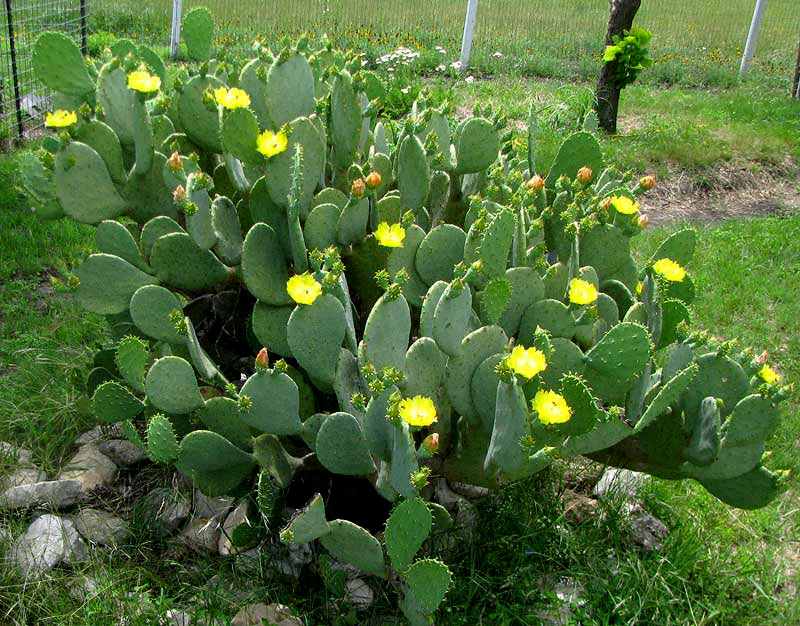
from the the June 9, 2013 Newsletter issued from the Frio Canyon Nature Education Center in northern Uvalde County, southwestern Texas, on the southern border of the Edwards Plateau; elevation ~1750m (~5750 ft); N29.62°, W99.86°; USA
MY BACKYARD SPINELESS PRICKLYPEAR
Behind the cabin there's a spineless cactus that doesn't look like the famously edible and fairly spineless Nopal Cactus, or Indian Fig, we've seen so much of in Mexico, and neither does it seem to be a mere spineless race of the common pricklypear cactus in our area, the Texas Pricklypear. I've been eager to see the flowers so I could identify the big cactus, and now this week the plant is ablaze with large, yellow blossoms, as shown above.
The main field marks identifying this cactus, besides its spinelessness and yellow flowers, is the fact that this cactus doesn't sprawl on the ground like our abundant Texas Pricklypear, which seldom stands higher than three or four pads, yet neither does it possess a tree-like trunk, like some pricklypear species. Nopal Cactus, or Indian Fig, does produce a trunk. You might want to compare the above photo with pictures on our Nopal Cactus page at http://www.backyardnature.net/mexnat/nopal.htm.
On that page you'll see that Nopal's pads can grow much larger than the largest pads of our backyard species, and most have a different shape.
The backyard spineless cactus's blossoms are bright yellow on the day they open, then the second day they tend to remain closed, and turn pinkish, as shown below:
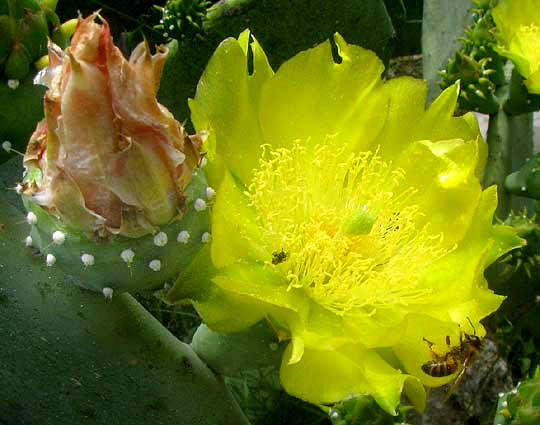
In that picture notice that the spherical stigma in the center of the many yellow anthers is a very pale green; stigma color in other species may be dark green, white, or other shades.
Another good field mark is that the older pads are a little silvery green, not the deep emerald green of many pricklypears. This silveriness is referred to as glaucescence, and you can see it below:
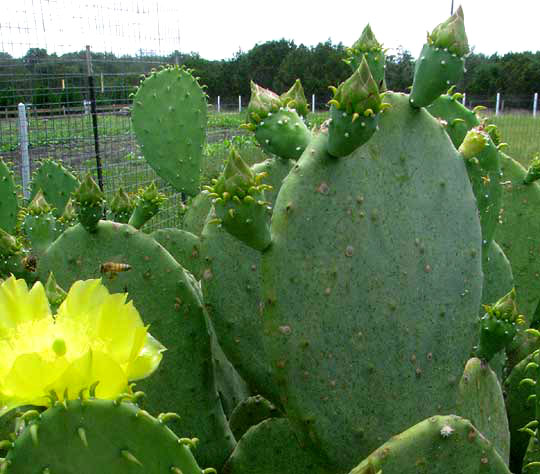
Happily, the incomplete online Flora of North America has its Cactus Family finished, and there I could "key out" our cactus. It's OPUNTIA ELLISIANA*, most commonly known as Spineless Pricklypear or Tiger Tongue. Some authorities regard Opuntia ellisiana as merely a spineless variant of Opuntia cacanapa of the Texas Big Bend area.
Whatever its "true identity," this spineless taxon doesn't seem to grow in the wild. I can't find anyone's theory on how the cultivar arose, but I have my own, especially because I'm in the process of reading the journal of Álvar Núñez Cabeza de Vaca, who in 1527 was shipwrecked on the Florida coast, then for eight years wandered through what is now the US and Mexico. His La Relación provides extraordinary accounts of America's indigenous people at that time, and their natural environment. Wikipedia's Cabeza de Vaca page.
Cabeza de Vaca wandered through this general area, often finding indigenous groups eating cactus fruits, and presumably they also ate the pads. I'd expect the indigenous people to have selectively bred pricklypear to get the spines off.
Whatever the history of Opuntia ellisiana, I'm tickled to know that that's who inhabits my backyard, and who in recent months has supplied so many tasty and nutritious meals. This is a wonderful cactus and I'll do my best to pass on pads to others who will plant them in their own backyards.
from the June 2, 2013 Newsletter issued from the Frio Canyon Nature Education Center in northern Uvalde County, southwestern Texas, on the southern border of the Edwards Plateau; elevation ~1750m (~5750 ft); N29.62°, W99.86°; USA
EATING SPINELESS PRICKLYPEAR
The six-ft-tall, spineless pricklypear cactus behind the cabin is issuing this season's new pads and flower buds, as shown below:
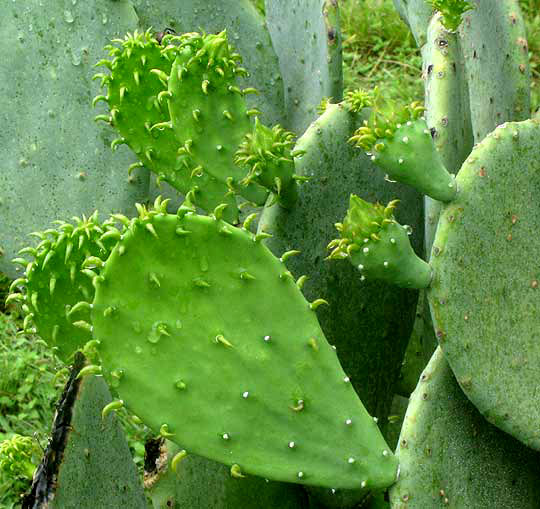
In that picture the new pads, which average about five inches long (13cm) are darker green, smaller and much better to eat than the older pads. I've eaten older pads, but they're tougher and not as tasty. In the above picture the edible pads are flat like beavertails, while the goblet-shaped items are flower buds. The little curved, conical items covering the pads and buds, and looking like green cat-claws, are vestigial leaves, left over from the early history of the evolution of the Cactus Family. At the bottom of the pad up front in the picture you can see where the leaves have fallen off on their own accord, leaving white spots.
Those white spots are the worst thing about harvesting and preparing cactus pads to eat, for -- even though the cactus lacks regular spines -- those little white spots are where a second kind of spine is found, a miniscule one only 1/16th of an inch (1-2mm) long, and even if you don't see them they stick into your fingers, or your lips and tongue if you eat pads bearing them, causing endless irritation. They're very hard to remove once they're stuck into you. You can see a close-up of one of the white spots -- referred to as an areole -- with two of the almost-microscopic spines we're talking about below:
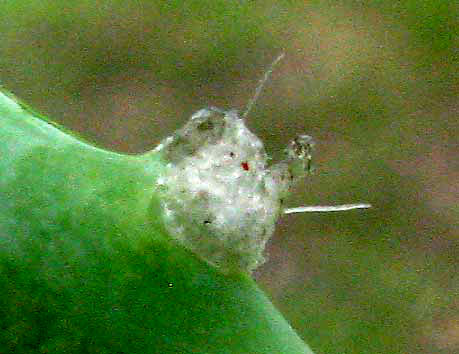 .
.These tiny spines are called glochids. The first thing to do after breaking off a newly emerged, dark green pad for eating is to remove every white spot, or areole, from the pad. You can see me doing exactly that below:
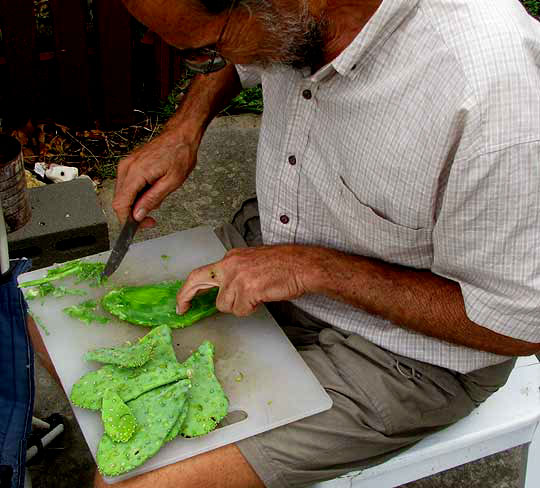
First you slice off the rim all around the pad, because areoles tend to congregate there. If the pad is fresh and young, you can scrape most of the areoles off by scratching a sharp, finely serrated knife across the pad's surface, as I'm doing in the photo. Remaining areoles must be removed individually with the knife's point. On older, tougher pads you may have to remove each areole one at a time. It's tedious, messy work. Scraping creates a bit of sticky slime that gets all over everything. Also, you should never start the work without having tweezers handy because you'll get at least one glochid in a finger and tweezers are how you remove them.
Once all areoles are removed, cut the pads into French-fry-size strips and fry them in a skillet with oil. I usually add them to onions and garlic I've sautéed while slicing the pads. You can see my skillet after the cactus was added, with my fast-stirring chopsticks at work, below:
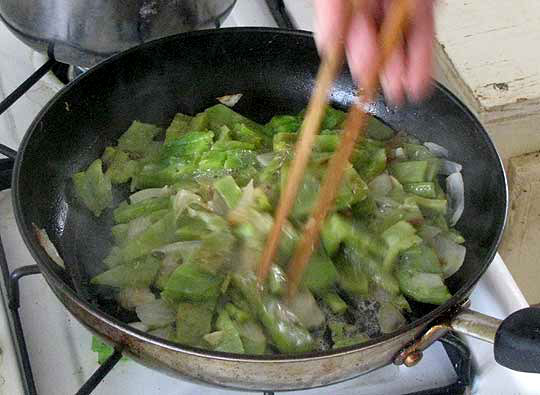
Usually when the dish is in this stage I scramble some eggs into the mixture, making a dish Mexicans call "nopalitos con huevos." You can also make a salad with the preparation, mixing it with chopped tomatoes, sliced white onions, chili peppers, cilantro, salt, pepper, lime juice, and some nice, tangy white cheese. A good webpage with more pictures and information is at http://chanfles.com/comida/nopalitos/.